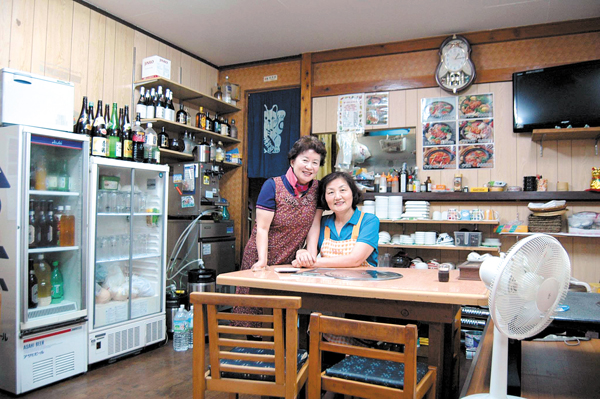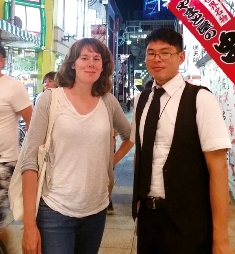| |
 |
|
| ▲ The Jeju community in Osaka is tight-knit, warm and proud of its heritage. Photo courtesy Moira Saltzman |
“You can take the halmang out of Jeju, but you can’t take Jeju out of the halmang,” says Moira Saltzman, a linguist researching the UNESCO critically endangered language of Jejueo, as we discuss her summer research trip to Osaka, Japan.
A Ph.D candidate at the University of Michigan, the American made the trip to record examples of unadulterated Jejueo which can be readily heard among the Korean diaspora of the “cloister enclave” of Tsuruhashi. Known as “Little Jeju,” it is home to around 50,000 Jeju settlers and an estimated 126,000 people of Jeju descent.
“The language there has a much more robust lexicon than here, where there has been a gradual shift toward standard Korean, such as in switching particles, even for fluent Jejueo speakers,” said Saltzman.
Saltzman was joined on the June trip by Tommy Tran, a UCLA Ph.D. candidate researching Jeju development, and he conjured up scenes of bustling markets filled with colorful characters, Jeju buckwheat pancakes, and even the occasional stone grandfather statue.
It is also a poorer part of town, said Tran, looked down upon by the wider Japanese community. “Even though it’s better now with tourism, there still is a stigma that it is a ghetto; younger people are actually leaving.”
Tran made the trip to hear firsthand accounts of 20th-century Jeju and he said the elders’ stories contain tantalizing glimpses of the Jeju of yesteryear, “the true Jeju” before radical change.
“The Osakan people have a more objective perspective on how things have changed. They went to Tsuruhashi before all the major developments... so they remember a vastly different Jeju than there is today,” he said.
From Jeju to Osaka
Although Korea-Japan migration stretches back millennia, the first modern record of migration from Jeju was in 1903, a time of deep poverty which pushed the young, adventurous and needy to seek new opportunities abroad.
Emigration from Jeju shot up after a new ferry line opened in 1923, and by 1938, 241,619 Koreans had settled in Osaka, including around 60,000 Jeju Islanders, around a quarter of the island population, according to a UN White Paper by David Rand.
The rapidly industrializing city provided an “excellent environment for the development of insular communities,” states Rand, and Saltzman confirmed that social mobility for Jaeil Jejuin, as they are known, was limited in the early days by deprivation and racism: “They could never get the job they wanted or marry [outside the community],” she said.
The immigrants entered the lower rungs of society, enduring the work the Japanese shunned: glass or metal factories, and pig farms. Many were conscripted under duress during World War II, as the Japanese war machine demanded labor.
Keeping connections
Hard work and a strong community spirit, however, meant that riches were made by a few, and much was sent back to their kinsfolk on the still-impoverished Jeju, beginning a tradition of philanthropy and investment that left its mark in agriculture, tourism and education.
“Their interest was in social development and, initially, it was agriculture, such as in mandarin farming, and also education; they donated 500,000 books to Jeju National University,” says Tran.
There is even interest in building a shopping mall on the island, with many Jaeil Jejuin keen to counter Chinese influence and refresh deep links: “They feel they are losing a connection with Jeju,” Tran added.
And this is why the work of Saltzman and Tran is so crucial, as the window of opportunity to record their stories and wisdom is narrowing every year.
| |
 |
|
|
▲ Moira Saltzman (left) and Tommy Tran.
Photo courtesy Moira Saltzman
|
Despite the Jeju language, for example, being spoken fluently by relatively younger people in Tsuruhashi than on Jeju itself — “they left Jeju while the language was still thriving so, they can be 50 and still fluent," said Saltzman — there has been no transmission to younger generations, who rarely even speak standard Korean.
In addition, while shamanism “exists strongly in Osaka,” says Tran, the lack of Jeju shamans — “they are dying out” — means they have been replaced by those in the mainland style. The local Jeju shrine, Yongwanggung, was also demolished in 2010 due to dwindling believers, he adds.
Renewing links
The boatloads of Jeju people to Osaka dried up in the 1980s as Jeju developed and the need to seek gainful employment abroad evaporated. As those with direct connections between the communities become fewer, more effort is needed to maintain this historic link.
Osaka’s Jaeil Jejuin are tied at the heart to Jeju, and both of the researchers recall the smiles that flashed across the faces of the elders as they recalled wild-vegetable foraging on the slopes of Hallasan, or old folk songs that had not passed their lips in decades.
“I want to see an awakening of their Jeju culture. I see that people are trying to retain it, so it’s only the beginning. Perhaps local NGOs, like Global Inner Peace, could take the lead.”
Saltzman agreed that it would be a travesty to lose the personal stories which shed light on this fascinating chapter in Japan-Korea relations.
“We only hit the tip of the iceberg... The door is shutting and interest is growing. Basically, we need more bodies to delve into more of the history.”
For more info on Japan's Jeju community, visit the Center for Zainichi Jeju People at Jeju National University, Daehang-ro, Jeju-si / 064-754-3975/3978 / Mon-Fri: 10am-5pm. |





















